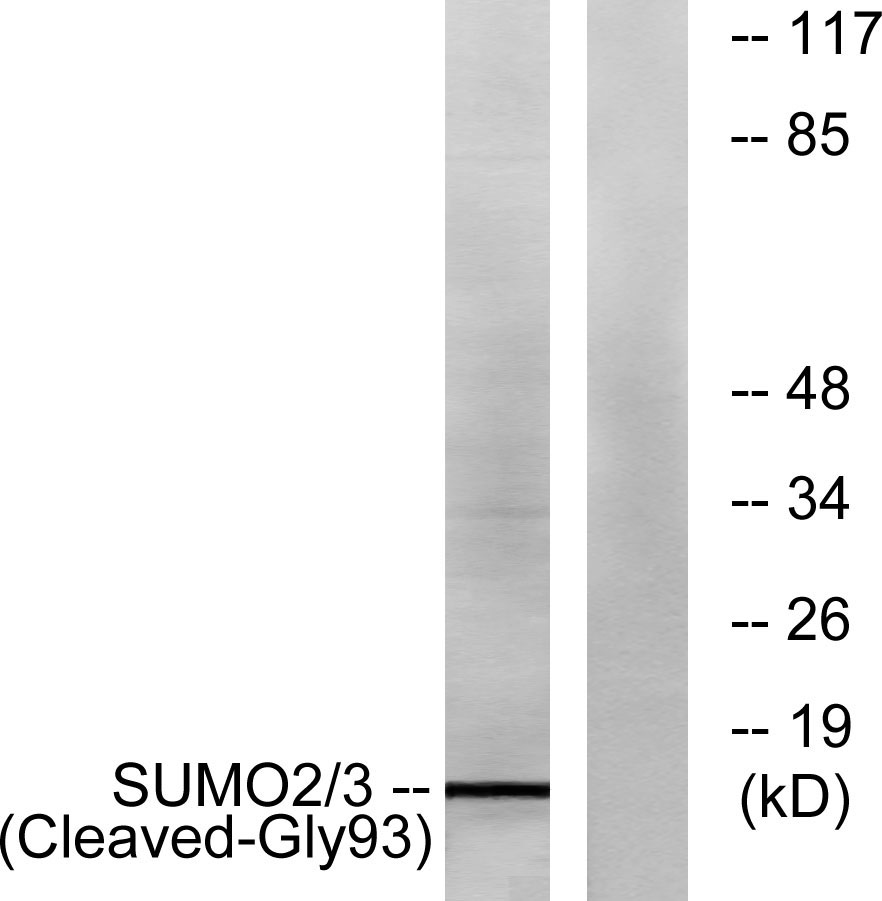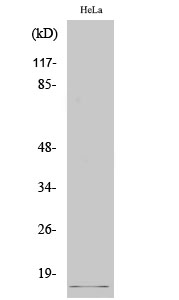产品名称
Cleaved-SUMO-2/3 (G93) Rabbit Polyclonal Antibody
别名
SUMO2; SMT3A; SMT3H2; Small ubiquitin-related modifier 2; SUMO-2; HSMT3; SMT3 homolog 2; SUMO-3; Sentrin-2; Ubiquitin-like protein SMT3A; Smt3A
蛋白名称
Small ubiquitin-related modifier 2
存储缓冲液
Liquid in PBS containing 50% glycerol, 0.5% BSA and 0.02% New type preservative N.
Human Gene Link
http://www.ncbi.nlm.nih.gov/sites/entrez?db=gene&term=6613
Human Swissprot No.
P61956/P55854
Human Swissprot Link
http://www.uniprot.org/uniprotkb/P61956/entry
Mouse Gene Link
http://www.ncbi.nlm.nih.gov/sites/entrez?db=gene&term=170930
Mouse Swissprot No.
P61957
Mouse Swissprot Link
http://www.uniprot.org/uniprot/P61957
Rat Gene Link
http://www.ncbi.nlm.nih.gov/sites/entrez?db=gene&term=690244
Rat Swissprot Link
http://www.uniprot.org/uniprot/P61959
免疫原
The antiserum was produced against synthesized peptide derived from human SUMO2/3. AA range:44-93
特异性
Cleaved-SUMO-2/3 (G93) Polyclonal Antibody detects endogenous levels of fragment of activated SUMO-2/3 protein resulting from cleavage adjacent to G93.
稀释度
WB 1:500 - 1:2000. ELISA: 1:20000. IP 1:50-100 Not yet tested in other applications.
宿主
Polyclonal, Rabbit,IgG
背景介绍
This gene encodes a protein that is a member of the SUMO (small ubiquitin-like modifier) protein family. It functions in a manner similar to ubiquitin in that it is bound to target proteins as part of a post-translational modification system. However, unlike ubiquitin which targets proteins for degradation, this protein is involved in a variety of cellular processes, such as nuclear transport, transcriptional regulation, apoptosis, and protein stability. It is not active until the last two amino acids of the carboxy-terminus have been cleaved off. Numerous pseudogenes have been reported for this gene. Alternate transcriptional splice variants, encoding different isoforms, have been characterized. [provided by RefSeq, Jul 2008],
细胞定位
Nucleus. Nucleus, PML body.
功能
function:Ubiquitin-like protein which can be covalently attached to target lysines either as a monomer or as a lysine-linked polymer. Does not seem to be involved in protein degradation and may function as an antagonist of ubiquitin in the degradation process. Plays a role in a number of cellular processes such as nuclear transport, DNA replication and repair, mitosis and signal transduction. Covalent attachment to its substrates requires prior activation by the E1 complex SAE1-SAE2 and linkage to the E2 enzyme UBE2I, and can be promoted by an E3 ligase such as PIAS1-4, RANBP2 or CBX4.,online information:SUMO protein entry,PTM:Cleavage of precursor form by SENP1 or SENP2 is necessary for function.,PTM:Cleavage of precursor form by SENP1, SENP2 or SENP5 is necessary for function.,PTM:Polymeric chains can be formed through Lys-11 cross-linking.,similarity:Belongs to the ubiquitin family. SUMO subfamily.,similarity:Contains 1 ubiquitin-like domain.,subcellular location:Nuclear bodies.,subunit:Homotrimer (Potential). Crystal packing analysis suggests a possible trimeric assembly, of which the biological significance remains to be determined. Interacts with SAE2 and UBE2I. Covalently attached to a number of proteins. Interacts with PELP1.,subunit:Interacts with SAE2 and UBE2I. Covalently attached to a number of proteins.,tissue specificity:Broadly expressed.,tissue specificity:Expressed predominantly in liver.,
纯化
The antibody was affinity-purified from rabbit antiserum by affinity-chromatography using epitope-specific immunogen.


